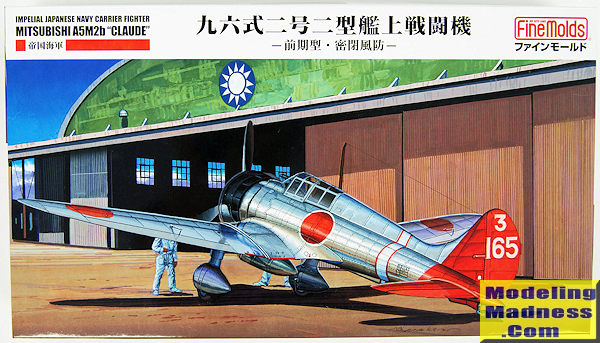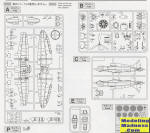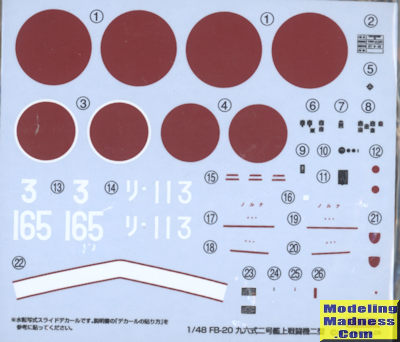
Fine Molds 1/48 A5M2b "Claude"
| KIT #: | FB 20 |
| PRICE: | 2720 yen (about $27) from www.hlj.com |
| DECALS: | Two options |
| REVIEWER: | Scott Van Aken |
| NOTES: | 2016 tooling |

| HISTORY |
The aircraft entered service in early 1937, soon seeing action in pitched aerial battles at the start of the Second Sino-Japanese War, including air-to-air battles with the Republic of China Air Force's Boeing P-26C Model 281 "Peashooters" in what was the world's first-ever aerial dogfighting and kills between monoplane fighters built of mostly metal.
Chinese Nationalist pilots, primarily flying the Curtiss Hawk III, put up a valiant fight against the Japanese, but the A5M was the better of almost every fighter aircraft it encountered. Though armed with only a pair of 7.7 mm machine-guns, the new fighter proved effective and damage-tolerant, with excellent maneuverability and robust construction. Later on A5M's also provided much-needed escorts for the then-modern but vulnerable Mitsubishi G3M bombers.
The Mitsubishi team continued to improve the A5M, working through versions until the final A5M4, which carried an external underside drop tank to provide fuel for extended range.
The A5M's most competitive adversary in the air was the Polikarpov I-16, a fast and heavily armed fighter flown by both Chinese Air Force regulars and Soviet volunteers. Fierce air battles in 1938, especially on 18 February and 29 April, ranked among the largest air battles ever fought at the time. The battle of 29 April saw 67 Polikarpov fighters (31 I-16s and 36 I-15 bis) against 18 G3Ms escorted by 27 A5Ms. Each side claimed victory: the Chinese/Soviet side claimed 21 Japanese aircraft (11 fighters and 10 bombers) shot down with 50 Japanese airmen killed and two captured having bailed out while losing 12 aircraft and 5 pilots killed; the Japanese claimed they lost only two G3Ms and two A5Ms shot down with no less than 40 Chinese aircraft shot down.
104 A5M aircraft were modified to accommodate a two-seater cockpit. This version, used for pilot training, was dubbed the A5M4-K. K version aircraft continued to be used for pilot training long after standard A5Ms left front-line service.
Almost all A5Ms had open cockpits. A closed cockpit was tried but found little favor among Navy aviators. All had fixed, non-retractable undercarriage. Wheel spats were a feature of standard fighters but not training aircraft.
The Flying Tigers encountered the Type 96, although not officially, and one was shot down at Mingaladon airfield, Burma on 29 January 1942.
Some A5Ms remained in service at the end of 1941 when the United States entered World War II in the Pacific. US intelligence sources believed the A5M still served as Japan's primary Navy fighter, when in fact the A6M 'Zero' had replaced it on first-line aircraft carriers and with the Tainan Kōkūtai in Taiwan. Other Japanese carriers and Kōkūtai (air groups) continued to use the A5M until production of the Zero caught up with demand. The last combat actions with the A5M as a fighter took place at the Battle of the Coral Sea on 7 May 1942, when two A5Ms and four A6Ms of the Japanese carrier Shōhō fought against US aircraft that sank their carrier.
In the closing months of the war most remaining A5M airframes were used for kamikaze attacks.
| THE KIT |
 The A5M has been kitted in this scale a few times, all of them either resin or short run injected plastic kits. To my knowledge, all have been the later variants. This is the first time I've seen one with the closed canopy done in this scale. It is a 2016 tooling and the details on the kit are really superb. I especially like that Fine Molds has molded each of the panels slightly differently to provide a sense of 'grain' in the metal sheets. It will be interesting to see how this turns out in the final build.
The A5M has been kitted in this scale a few times, all of them either resin or short run injected plastic kits. To my knowledge, all have been the later variants. This is the first time I've seen one with the closed canopy done in this scale. It is a 2016 tooling and the details on the kit are really superb. I especially like that Fine Molds has molded each of the panels slightly differently to provide a sense of 'grain' in the metal sheets. It will be interesting to see how this turns out in the final build.
The cockpit is very nicely done and has proper sidewall frame detail as well as what few boxes were attached to them. There are decals to fit on the instruments and one is provided with quite a bit of detail. All of this is painted in what is listed as Mitsubishi cockpit color, though some bits are in the metallic blue-green color. This latter color is used on the inside of flap wells and such.
Fine Molds has produced an excellent engine that is complete with pushrod assemblies, intake and exhaust piping as well as the electrical harness. It fits into a three piece cowling that is split into upper and lower sections with a separate cowl flap piece. Flaps can be display raised or lowered.
 The wheel pants are two part and the wheels have grooves in them so they can be inserted after the airframe has been painted. You can open holes for a bomb rack and a fuel tank, though I'm not sure if this version actually carried either so check references. A full pilot figure is provided to man the cockpit. No belts are provided, but the aftermarket folks can take care of that for you.
The wheel pants are two part and the wheels have grooves in them so they can be inserted after the airframe has been painted. You can open holes for a bomb rack and a fuel tank, though I'm not sure if this version actually carried either so check references. A full pilot figure is provided to man the cockpit. No belts are provided, but the aftermarket folks can take care of that for you.
You have two canopy options. One is a single piece with the windscreen, canopy, and rear section in one piece. The other is separated so you can display the cockpit detail.
Instructions are mostly in Japanese, but should be no issue for most of us. There are several paint references offered, one of which is Tamiya and one other is obviously Gunze. Both options are unpainted metal with red tail sections and a black cowling. The box art plane has a white fuselage stripe and the other does not. The box art plane is with the 12th Air Group in China during 1937/38. The other is with the the Hyakurihara Naval Air Group in Japan, with no date provided. Decals look to be excellent and provide what little stencils these aircraft carried.
| CONCLUSIONS |
Pre-war Japanese planes often get overlooked by many western modelers. This is a neat one and thanks to the low level of complexity, will not only make into a nice model, but shouldn't drive anyone to distraction!
| REFERENCES |
October 2016
Copyright ModelingMadness.com. All rights reserved.
Thanks to www.hlj.com for the preview kit. Get yours today at this link.
If you would like your product reviewed fairly and fairly quickly, please contactthe editor or see other details in the